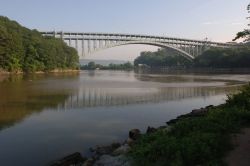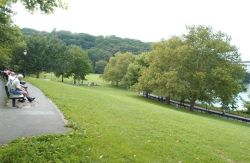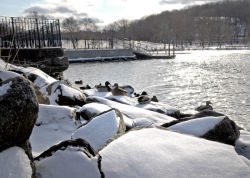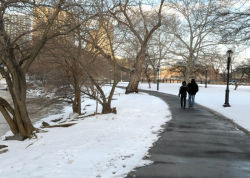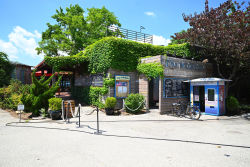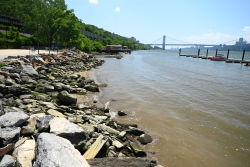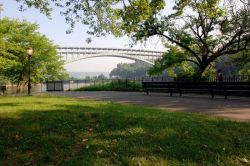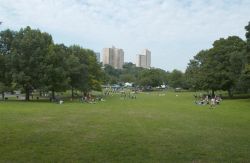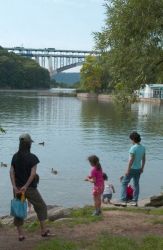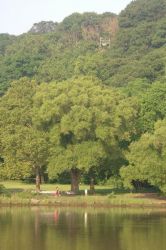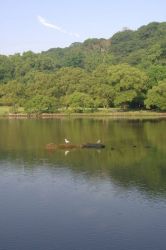Inwood Hill Park
Emerson Playground
This playground is named for Emerson Street, a westward extension of 207th Street, which once curved into a semi-circle and connected to Isham Street. It was largely demapped and integrated into Inwood Hill Park in 1925 when Parks acquired the parcel of land on which this play area stands.
Emerson Street was named for Ralph Waldo Emerson (1803-1882), the influential American writer, lecturer, and poet. Emerson followed in the footsteps of his father, a prominent Unitarian minister in Boston, and enrolled at Harvard Divinity School in 1825. In 1829 he was ordained as a junior minister at the 2nd Unitarian Church in Boston, but he did not last long in the pulpit. Already conflicted internally, Emerson resigned his pastorate when his young wife, Ellen Tucker, died in 1831. He sailed the next year for Europe, and stayed there for two years, meeting such prominent writers and thinkers as Samuel Taylor Coleridge (1772-1834), William Wordsworth (1770-1850), Thomas Carlyle (1795-1881), and Walter Savage Landor (1775-1864). Their influence was instrumental in the formulation of his own philosophy. Upon his return, he remarried and settled in Concord, Massachusetts.
Essays such as Nature (1836) and Self-Reliance (1841) earned Emerson acclaim as a writer and broadened his popularity as a lecturer. Emerson also published a journal, The Dial, which provided another platform from which he spread his philosophical ideals and became a chief spokesman for the Transcendentalist school of thought. At its core, Transcendentalism held that man and nature and the universe are essentially the same, and are ordered by a Supreme Mind or Over-Soul; therefore, humanity is divine, and humans should learn to “Trust thyself,” which became a central motto of the movement. “…the world globes itself in a drop of dew,” is one expression of the Transcendentalist view.
In 1843, The Dial published the essay “A Winter Walk,” by writer and naturalist Henry David Thoreau (1817-1862), most famous for Walden (1854). Thoreau, a friend and neighbor of Emerson’s, had been a teacher until Emerson introduced him to Transcendentalism. Emerson encouraged Thoreau’s career – and Walden Pond, where Thoreau lived for two years, two months, and two days, was on property owned by Emerson.
This playground is located on the periphery of Inwood Hill Park - a fitting place to bear Emerson’s name. Inwood Hill Park contains the last natural forest and salt marsh in Manhattan, and human activity has been documented in its environs since prehistoric times. Lenape (Delaware) Native Americans inhabited the area through the 17th century, and there is evidence of a main encampment along the eastern edge of the park.
In the 17th and 18th centuries, colonists from Europe settled and farmed here. During the Revolutionary War, American forces built a five-sided earthwork fort (known as Fort Cock or Fort Cox) in the northwestern corner of the park. It fell to British and Hessian troops in November 1776 and was held until the war ended in 1783.
In the 1800s, much of the park contained country homes and philanthropic institutions, including a charity house for women and a free public library which became the Dyckman Institute. When Parks bought the land in 1916, the salt marsh was saved and landscaped, and a portion was later filled. During the Depression, the city employed Works Progress Administration laborers to build many of the roads and trails of Inwood Hill Park and demolish all remaining structures. Emerson Playground was created in 1939, one of many 255 playgrounds built in the 1930s by Parks Commissioner Robert Moses (1888-1981).
Located on the corner of Isham Street and Seaman Avenue, Emerson Playground provides an area for organized play in the wilderness of Inwood Hill Park. In 1997, Council Member Stanley Michels funded a $520,000 reconstruction of the playground. The site now features benches, game tables, two sets of swings- and modular play equipment with safety surfacing. In addition, two pieces of animal art grace the playground - a spray shower in the form of a frog, and a wolf sculpture in iron bas-relief
Check out your park's Vital Signs
Clean & Safe
Green & Resilient
Empowered & Engaged Users
Share your feedback or learn more about how this park is part of a
Vital Park System

Know Before You Go


